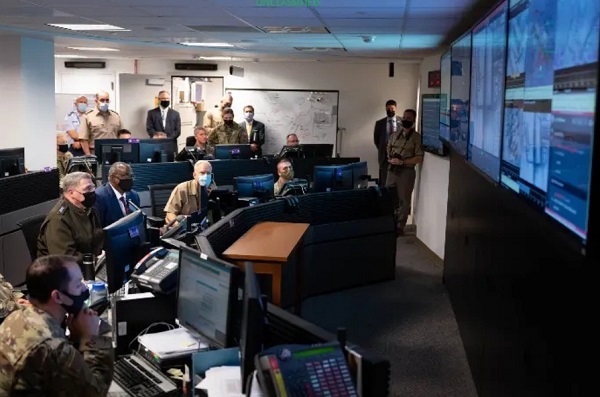New Delhi, (Samajweekly) The US has announced that it will go hard against ISIS-K, the terror group, which has claimed responsibility for the twin suicide bombing at Kabul airport, which killed over a 100 people, including 13 American Marines.
“I would tell you that we’re going to do everything that we can to make sure we remain focused on ISIS-K, understand that network, — and at the time of our choosing in the future, hold them accountable for what they’ve done,” US Secretary of Defence Lloyd Austin said on Wednesday.
Austin was also non-committal about Washington’s relationship with the Taliban in the future.
Having served in Afghanistan before, Austin also stressed that the US was working with the Taliban on a “very narrow set of issues” and would not make “any leaps of logic” to how things will shape up in the future.
“We don’t know what the future of the Taliban is, but I can tell you from personal experience that this is a ruthless group from the past, and whether or not they change remains to be seen,” said the US Joint Chiefs of Staff Chairman General Mark Milley.
Meanwhile, two days after Major General Chris Donahue boarded the final flight out of the Kabul airport to end America’s longest war, the White House, US Department of State and country’s Department of Defence released more details of the intense, massive operation which is not over yet.
India Narrative has put together for its readers some of the salient bits:
How many Americans are still left behind in Afghanistan?
The US Department of State believes there are between 100 and 200 Americans who remain in Afghanistan who may have some interest in leaving. Diplomatic efforts continue to ensure safe passage for them and for any Afghan partners and foreign nationals who still want to leave Afghanistan. According to the US President Joe Biden, there is no deadline on the effort to ensure safe passage for those who want it.
How many military personnel were involved in the non-combatant evacuation operation?
According to the US Joint Chiefs of Staff Chairman General Mark Milley, between five to six thousand military personnel were deployed on the ground, some of whom were forward-deployed based on the contingency planning. These elements came from the 82nd Airborne Division, Special Forces, the Marine Corps, along with Navy and Air Force personnel.
How many people did the US evacuate from Afghanistan?
The United States evacuated some 6,000 American citizens and a total of more than 124,000 civilians, including at-risk Afghans. “And, we did it all in the midst of a pandemic and in the face of grave and growing threats,” told US Secretary of Defence Lloyd Austin.
How many sorties were conducted by the US military and other partners?
A total of 778 sorties evacuated a total of 124,334 people which included almost 6,000 American citizens, third country nationals, and Afghans designated by the US Department of State. Out of these 778, as many as 387 were the US military C-17 and C-130 sorties and the rest 391 the non-US military sorties enabled by the US forces.
Where were the people evacuated from Kabul taken to?
The evacuation mission was conducted across nine countries in Europe and the Middle East and 26 intermediate staging bases and temporary safe havens. More than 65,000 Afghans and others have transited through the Gulf with Qatar being the largest evacuation site. Biometric and biographic screening on the Afghan evacuees is done before they are brought to the United States or processed for a third country.
How many have actually made it to the US?
Since August 17 to August 31, as many as 31,107 people have arrived in the US as part of the evacuation operation. Out of them, 4,446, or about 14 percent, are US citizens; 2,785, or about 9 percent, are Lawful Permanent Resident (LPRs), and the remaining 23,876 individuals, making about 77 percent, are Afghans at risk.
How many US soldiers served in Afghanistan over the last 20 years?
Eight-hundred-thousand as the US spent over $1 trillion and lost 2,461 servicemen, sailors, airmen and Marines while 20,691 were wounded. “Untold thousands of others suffer with the invisible wounds of war as we close this chapter in our nation’s history, and all of those casualties are alongside our allies and partners, and we should never forget that 60,000 Afghan National Security Forces gave their lives in the conduct of this war,” said General Mark Milley.
Is the evacuation mission over?
The Afghan task force continues to work 24/7 on evacuation efforts. Since August 14, the task force has been engaging American citizens in Afghanistan, making more than 55,000 phone calls and has sent more than 33,000 emails. “This outreach continues today and will in the days and weeks ahead as long as there is a need,” said Ambassador Victoria Nuland, the US Under Secretary for Political Affairs, yesterday.
Was it just a military mission?
No. The US Department of State says that Secretary Antony Blinken has made more than 50 bilateral calls to foreign leaders and met virtually with both his G7 and NATO counterparts, besides convening a virtual ministerial on Monday that included Canada, France, Germany, Italy, Japan, the UK, EU, and NATO, as well as Qatar and Turkey, to discuss the facilitation of safe travel out of Afghanistan, including reopening Kabul’s civilian airport.
Is there no US diplomatic presence in Kabul now?
No. The US has set up its Afghan office in Doha, led by Ian McCary, who has served as the Deputy Chief of Mission in Afghanistan, to manage diplomacy in all of its aspects with Afghanistan, and to work with allies and partners who have also relocated their operations to Doha.










